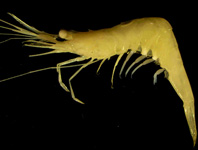Abstract
This paper describes the previously unknown larva of Plectrocnemia scruposa McLachlan 1880. Information on the morphology of the 5th larval instar is given, and the most important diagnostic features are illustrated. In the context of existing identification keys, P. scruposa keys together with P. brevis McLachlan 1871, P. conspersa (Curtis 1834), and P. laetabilis McLachlan 1880. These species can be separated by the length of the outermost seta of the posterolateral trio on the last abdominal tergum and by presence/absence of a central pigmented mark on the posterior margin of the labrum. According to mandible morphology, the larva of this species appears to be mainly a predator and passive filter feeder of particulate organic matter.
References
Coppa, G. (2011) Description de l’adulte mâle de Plectrocnemia cevennensis n. sp. de la faune de France (Trichoptera, Polycentropodidae). Ephemera, 12 (1), 1–5.
Curtis, J. (1834) XXXVII. Descriptions of some hitherto nondescript British species of may-flies of anglers. The London and Edinburgh Philosophical Magazine and Journal of Science, 4, 212–218.
https://doi.org/10.1080/14786443408648304
Edington, J.M. & Hildrew, A.G. (1995) A revised key to the caseless caddis larvae of the British Isles with notes on their ecology. Freshwater Biological Association Scientific Publication, 53, 1–134.
González, M.A. & Menéndez, J.M. (2011) Checklist of the caddisflies of the Iberian Peninsula and Balearic Islands (Trichoptera). Zoosymposia, 5, 115–135.
https://doi.org/10.11646/zoosymposia.5.1.10
Graf, W., Murphy, J., Dahl, J., Zamora-Muñoz, C. & López-Rodríguez, M.J. (2008) Volume 1—Trichoptera. In: Schmidt-Kloiber, A. & Hering, D. (Eds.), Distribution and Ecological Preferences of European Freshwater Organisms. Pensoft Publishers, Sofia, Moscow, pp. 1–388.
Hickin, N.E. (1967) Caddis Larvae. Hutchinson & Co. Publishers, London, 476 pp.
Malicky, H. (1975) Fünfzehn neue mediterrane Köcherfliegen. Mitteilungen der Entomologischen Gesellschaft Basel, Neue Folge, 25, 81–96.
Malicky, H. (2004) Atlas of European Trichoptera. 2nd Edition. Springer, Dordrecht, 359 pp.
https://doi.org/10.1007/978-1-4020-3026-0_1
Malicky, H. (2005) Ein kommentiertes Verzeichnis der Köcherfliegen (Trichoptera) Europas und des Mediterrangebietes. Linzer Biologische Beiträge, 37, 533–596.
Malicky, H. (2009) Rote Liste der Köcherfliegen Österreichs (Insecta: Trichoptera). In: Zulka, K.P. (Ed.), Rote Liste gefährdeter Tiere Österreichs. Teil 14/3. Flusskrebse, Köcherfliegen, Skorpione, Weberknechte, Zikaden. Umweltbundesamt. Böhlau Verlag, Wien, pp. 1–534.
McLachlan, R. (1871) The species of the Trichopterous genus Plectrocnemia. The Entomologist’s Monthly Magazine, 8, 143–146.
McLachlan, R. (1880) A Monographic Revision and Synopsis of the Trichoptera of the European Fauna. Second Additional Supplement. John van Voorst and Friedlander & Sohn, London and Berlin, 76 pp.
Ocharan, R., Ocharan, F.J. & Anadón, A. (2006) Tricópteros de la Reserva de la Biosfera de Muniellos y de Asturias (N de España). Boletín de la Asociación Española de Entomología, 30, 161–197.
Roy, D., Décamps, H. & Harper, P.P. (1980) Taxonomy of male and female Plectrocnemia (Trichoptera; Polycentropodidae) from the French Pyrenees. Aquatic Insects, 2, 19– 31.
https://doi.org/10.1080/01650428009361004
Santoul, F., Figuerola, J., Mastrorillo, S. & Céréghino, R. (2005) Patterns of rare fish and aquatic insects in a southwestern French river catchment in relation to simple physical variables. Ecography, 28, 307–314.
https://doi.org/10.1111/j.0906-7590.2005.04070.x
Stephens, J.F. (1836–1837) Illustrations of British Entomology; or, a Synopsis of Indigenous Insects: Containing Their Generic and Specific Distinctions; with an Account of their Metamorphoses, Times of Appearance, Localities, Food, and Economy, as far as Practicable. Vol. VI. Mandibulata. Baldwin & Cradock, London, 240 pp.
Vieira-Lanero, R. (2000) Las larvas de los Tricópteros de Galicia (Insecta: Trichoptera).
Tesis Doctoral, University of Santiago de Compostela, Santiago de Compostela, Galicia, 611 pp.
Vieira-Lanero, R., Gonzáles, M.A. & Cobo F. (2009) The larva of Plectrocnemia laetabilis McLachlan, 1880 (Trichoptera; Polycentropodidae; Polycentropodinae). Annales de Limnologie, 39, 135–139.
https://doi.org/10.1051/limn/2003011
Wallace, I.D. & Wallace, B. (1983) A revised key to larvae of the genus Plectrocnemia (Polycentropodidae: Trichoptera) in Britain, with notes on Plectrocnemia brevis McLachlan. Freshwater Biology, 13, 83–87.
https://doi.org/10.1111/j.1365-2427.1983.tb00659.x
Waringer, J. & Graf, W. (2011) Atlas of Central European Trichoptera Larvae. Erik Mauch Verlag, Dinkelscherben, 468 pp.
Waringer, J. & Graf, W. (2013) Key and bibliography of the genera of European Trichoptera larvae. Zootaxa, 3640 (2), 101–151.
https://doi.org/10.11646/zootaxa.3640.2.1
Waringer, J. & Malicky, H. (2019) The larva of Plectrocnemia renetta Malicky 1975 (Trichoptera, Polycentropodidae), including a discriminatory matrix to the larvae of Plectrocnemia Stephens 1836 species of Greece. Zootaxa, 4568 (2), 372–382.
https://doi.org/10.11646/zootaxa.4568.2.11
Wiggins, G.B. (1996) Larvae of the North American Caddisfly Genera (Trichoptera). 2nd Edition. University of Toronto Press, Toronto, 457 pp.
https://doi.org/10.3138/9781442623606
ZOBODAT (2011) Zoological Botanical Database of the State Museum of Upper Austria. Available from: http://www.biologiezentrum.at/de/bz/ (accessed 4 February 2020)


